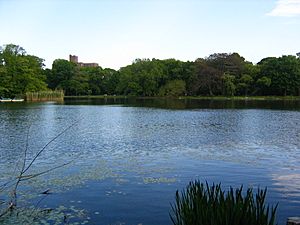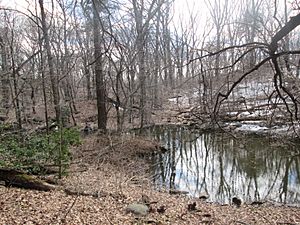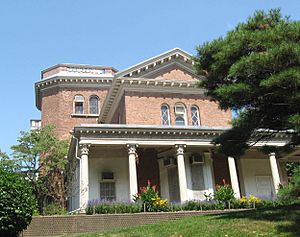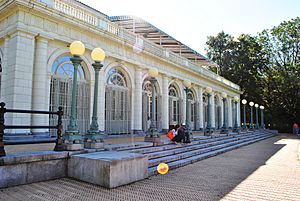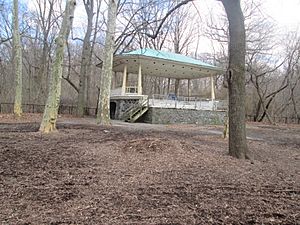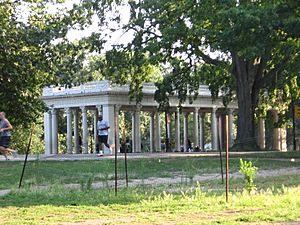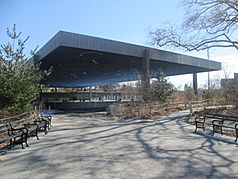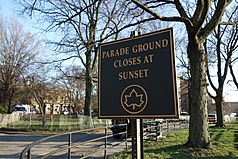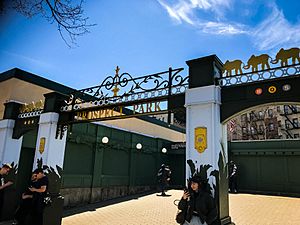Prospect Park (Brooklyn) facts for kids
Quick facts for kids Prospect Park |
|
|---|---|
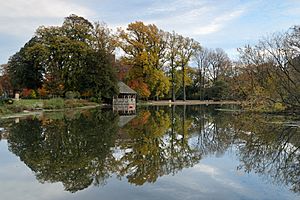 |
|
| Type | Urban park |
| Location | Brooklyn, New York City, United States |
| Area | 526 acres (2.13 km2) |
| Created | 1867–1873 |
| Owned by | NYC Parks |
| Operated by | Prospect Park Alliance |
| Visitors | about 8–10 million annually |
| Status | Open all year |
| Public transit access | Subway and bus; see below |
| Architect | Frederick Law Olmsted (1822–1903), Calvert Vaux (1824–1895) |
| NRHP reference No. | 80002637 |
| Significant dates | |
| Added to NRHP | September 17, 1980 |
Prospect Park is a large, beautiful park in Brooklyn, New York City. It's like a giant green playground and peaceful escape in the middle of the city. The park covers about 526 acres, making it the second largest public park in Brooklyn.
Famous designers Frederick Law Olmsted and Calvert Vaux, who also created Central Park in Manhattan, designed Prospect Park. It first opened in 1867. Over the years, many new features and improvements have been added.
Some of the park's main attractions include the huge Long Meadow, the Prospect Park Zoo, a pretty Boathouse, and Brooklyn's only lake. There are also places for sports like tennis, basketball, and baseball. In the summer, you can enjoy free outdoor concerts at the Prospect Park Bandshell.
Prospect Park is an important historical site. It was named a New York City landmark in 1975 and added to the National Register of Historic Places in 1980. Today, the park is managed by the Prospect Park Alliance and NYC Parks.
Contents
Discovering Prospect Park's Past
How the Park Area Was Formed
About 17,000 years ago, a giant glacier helped shape the land where Prospect Park now stands. It left behind hills and valleys. Mount Prospect, one of Brooklyn's tallest hills, is 200 feet high. This area was once covered in forests, but it became open fields after people settled there. Some old trees still remain in places like the Prospect Park Ravine. People call this "The Last Forest of Brooklyn."
A Place of History: The Battle of Long Island
During the American Revolutionary War (1775–1783), a major battle happened right here. It was called the Battle of Long Island (also known as the Battle of Brooklyn). American soldiers tried to defend a spot called Battle Pass. Even though the Americans lost the battle, their brave fight allowed George Washington's army to escape. Today, plaques and a monument honor this important event.
In 1856, the City of Brooklyn built a reservoir on Prospect Hill. The need to protect this area and the historic Battle Pass helped lead to the idea of creating a large park.
Planning the Park's Design
The idea for Prospect Park began in 1859. Brooklyn was growing fast and needed a big public park. James S. T. Stranahan, a park leader, believed a park would help everyone enjoy fresh air and exercise. He also thought it would attract wealthy families.
In 1865, Calvert Vaux suggested a new design for the park. He wanted a lake and didn't want a main road to cut through the park. Vaux's plan created the park we see today: a large meadow, a wooded ravine, and a lake. He also planned the oval plaza at the park's northern end, which is now Grand Army Plaza.
Vaux then asked Frederick Law Olmsted to join the project. Together, they finalized the park's design. They bought more land, including a large plot owned by Edwin Clarke Litchfield, where his home, Litchfield Villa, still stands. The park was also built around an existing Quaker cemetery, which remains a private cemetery today.
Building the Park
Construction on Prospect Park began in June 1866. Workers drained the land and built roads, paths, and trails. They created three main scenic roads: West, Center, and East Drives. Hundreds of workers helped shape the park, removing obstacles and improving natural features.
The first part of the park opened on October 19, 1867, even though it was still being built. People loved it! By 1868, 100,000 people visited each month. The park became very popular, especially on Sundays.
Prospect Park was mostly finished by 1873. However, a financial crisis that year stopped Olmsted and Vaux from building everything they planned. Still, the park cost over $9 million to create, which was a huge amount of money back then.
James Stranahan was known as the "Father of Prospect Park" because he led the project for 22 years. He made sure the park was built and protected its design. A statue honoring him stands at the Grand Army Plaza entrance.
Changes Over Time: Late 1800s to Early 1900s
After it opened, Prospect Park was a popular spot for sports like archery and croquet. In winter, people ice skated on the lake. The park was also a favorite place for picnics.
By the 1880s, the park needed repairs due to heavy use. The city spent money to fix paths, replant trees, and restore the park's beauty. In the 1890s, the park and its surroundings were improved even more. Grand Army Plaza was redesigned with grand columns and statues. Many park entrances also got a new, fancy look.
New buildings appeared inside the park too. The Rose Garden and the Vale of Cashmere were created. The Maryland Monument was built in 1895 to honor soldiers who fought in the Battle of Long Island.
When Brooklyn joined New York City in 1898, Prospect Park had about 15 million visitors each year. More structures were built in the early 1900s, including the beautiful Boathouse (1905).
The Robert Moses Era
In 1934, Robert Moses became the commissioner of NYC Parks. He used government money to build many new things in Prospect Park. The Prospect Park Zoo opened in 1935. The Bandshell and five playgrounds were also built. The Carousel, a gift from a kind person named Michael Friedsam, opened in 1949.
During World War II, parts of Prospect Park were used for defense. Soldiers were stationed there to protect the city from air attacks.
In the 1960s, a skating rink, the Kate Wollman Skating Rink, was built on part of Prospect Lake. This changed the lake's original design. Moses focused on making the park modern and good for sports. Many older structures were removed during this time.
After Moses left in 1960, the Parks Department faced challenges. There wasn't enough money for maintenance, and the park started to decline. By 1979, park visits dropped to their lowest point.
Saving Prospect Park: Late 1900s to Today
In the 1960s, people started to worry about historic buildings being torn down. In 1964, the city almost demolished the Boathouse. But a group called The Friends of Prospect Park fought to save it, and they succeeded!
By the late 1960s, projects began to restore the park. The city spent millions of dollars to fix up the Boathouse, dredge the lake, and restore gardens. The Prospect Park Carousel was also restored.
In the 1970s, crime became a problem in the park. But in the 1980s, the city invested $17 million to clean it up. Park visits grew from 2 million to 5 million visitors each year.
The Prospect Park Alliance, a non-profit group, was created in 1987. They worked with NYC Parks to restore many parts of the park. They fixed the Carousel and the Ravine. The Boathouse became home to the National Audubon Society, a group that helps birds.
In the 2000s, the old Wollman Rink was replaced by the new LeFrak Center at Lakeside. This modern facility opened in 2013 and offers ice-skating, boating, and more. The park continues to be improved with new entrances, renovated fields, and restored natural areas.
Exploring Prospect Park's Design
How the Park Was Planned
Frederick Law Olmsted and Calvert Vaux designed Prospect Park to look like beautiful paintings of nature. They wanted visitors to feel like they were in a peaceful countryside, even though they were in a city. They were inspired by parks in other countries, like Birkenhead Park in the United Kingdom.
The designers wanted people to explore the park in many different ways. They created the Long Meadow from hilly land and swamps. They carefully planted trees and shaped the land to make it feel vast and open. They also made the paths winding so that the park would seem even bigger.
Park Layout: Zones of Fun
Prospect Park is divided into three main areas, each with its own feel:
- The Long Meadow: This is a huge, open grassy area on the west side of the park. It's perfect for picnics, playing games, and relaxing. You'll find playgrounds, the Bandshell, and the Picnic House here.
- The Ravine: This is a wooded area in the middle of the park. It has streams and Brooklyn's only remaining old-growth forest, called the Midwood. It's a great place to explore nature.
- The Lake: Located on the south side of the park, this 60-acre lake is a beautiful spot for boating and enjoying the water. It has islands and a peninsula.
The Parade Ground, a large area for sports fields, is located separately at the park's far southwestern corner.
Nature's Wonders in Prospect Park
The Watercourse: A Flowing Journey
All the waterways in Prospect Park are part of one human-made system. A winding stream with ponds flows into the large lake at the park's south end. The designers used natural glacier-formed ponds to create this system. The watercourse is home to many birds and fish.
The water starts at Fallkill Falls in the center of the park. It flows through different pools and under bridges, eventually reaching the Lullwater, a small pond with the Boathouse. Finally, it empties into Prospect Lake.
The park has a special system to manage the water. Plants along the watercourse help absorb rain, and park staff can control the water flow to prevent flooding.
The Lake: A Hub of Activity
Prospect Lake is a 60-acre artificial lake. It has several islands and is home to over 20 types of fish. Fishing contests are held here every year. You can also explore the lake in kayaks or pedal boats, or ride the Independence, a replica of an old electric boat.
In the past, people used to ice skate on the lake in winter. But now, winters are warmer, and the ice isn't thick enough. Ice skating moved to the Kate Wollman Rink in 1960, and now to the LeFrak Center at Lakeside.
The Ravine: Brooklyn's Last Forest
The Ravine is a 146-acre wooded area in the park's center. It contains the start of the park's water system and Brooklyn's only old-growth forest, the Midwood. Olmsted and Vaux designed the Ravine to look like a mountain gorge.
For many years, the Ravine was neglected. But in 1996, a big restoration project began. The Ravine was opened for tours a few years later, allowing people to enjoy its natural beauty once again.
South of the Ravine is the Nethermead, a large meadow. To the southwest is Lookout Hill.
The Long Meadow: A Vast Green Space
The Long Meadow stretches along the western side of Prospect Park. It's a mostly flat, open area. It has playgrounds, the Tennis House, the Picnic House, and the Bandshell. The designers wanted the Long Meadow to create a peaceful view between the park and the neighborhoods nearby.
The Long Meadow was originally used for sports like archery and baseball. Sheep even grazed here until the 1930s to keep the grass trimmed! Today, it's still used for many activities, including baseball games on its seven fields.
Animals and Plants in Prospect Park
As of 2018, Prospect Park has about 30,000 trees, with around 200 different kinds! Most of these trees were planted by hand. The Prospect Park Alliance regularly takes care of the park's plants, removing unwanted species and adding native ones. The park has four "great trees" that are very special, including a rare Camperdown Elm.
Prospect Park is also a fantastic place for birds. Hundreds of different bird species stop here during their migrations. Birdwatchers have seen almost 300 different kinds of birds in the park over the years! Popular spots for birds include Lookout Hill, Quaker Hill, the Ravine, and the Vale of Cashmere.
You can also find other animals in the park, like turtles, bullfrogs, fish, and squirrels. Butterflies are common, and in recent years, more bats have been seen flying around.
Important Places and Buildings
Park Entrances and Plazas
Prospect Park has many entrances around its edges. Three main plazas mark the corners of the park:
- Grand Army Plaza: This large oval plaza is at the northern corner. It's the park's main entrance and features the impressive Soldiers' and Sailors' Arch, built in 1892. The plaza also has fountains and statues.
- Bartel-Pritchard Square: This circle is at the far western corner. It's named after two Brooklyn residents who died in World War I.
- Machate Circle: Located at the southwestern corner, this circle was renamed in 1989 to honor a police officer.
Other important entrances include those at the Parade Ground, Parkside and Ocean Avenues, and Willink Hill. Many of these entrances have beautiful designs from the late 1800s and early 1900s.
Bridges: Connecting the Park
Prospect Park has several arched bridges that allow people to walk under roads. This was a new idea when the park was built, keeping walkers safe from carriages. Five arched bridges were built in the late 1860s and early 1870s:
- Endale Arch: Located near the Grand Army Plaza entrance, this arch was one of the first to be completed in 1868.
- East Wood Arch: Also completed in 1868, it connects to the Willink Hill entrance.
- Meadowport Arch: Found on the northwest side of Long Meadow, it was finished in 1870.
- Nethermead Arch: This bridge has three arches and is considered one of the most amazing structures in any city park. It was completed around 1870.
- Cleft Ridge Span: Opened in 1872, this was the last arch built. It might have been the first concrete arch in the United States.
Other bridges, like Lullwater Bridge and Terrace Bridge, cross the park's watercourse. They were built to handle car traffic.
Roads and Trails: Ways to Explore
Prospect Park has a system of scenic drives: West, Center, Wellhouse, and East Drive. These roads are also used for walking and biking. In 2018, cars were completely banned from the park's drives, making them safer for everyone. The drives are now special lanes for bikes.
The park also has four hiking trails: the Lullwater, Midwood, Peninsula, and Waterfall trails. They are all considered "easy" and range from 0.5 to 1.0 miles long.
Monuments and Statues: Honoring History
Prospect Park has many statues and monuments that honor important people and events:
- A bronze statue of Abraham Lincoln, located in the Concert Grove.
- A statue of James S.T. Stranahan, the "Father of Prospect Park," near the Grand Army Plaza entrance.
- The Lafayette Memorial, honoring Gilbert du Motier, Marquis de Lafayette, at the Ninth Street entrance.
- The Maryland Monument, a column near Terrace Bridge, remembering the brave soldiers of the Maryland 400 in the Battle of Long Island.
- The Prospect Park War Memorial, honoring soldiers who died in World War I.
- Statues of famous composers like Beethoven and Mozart in the Concert Grove.
- A proposed monument of Shirley Chisholm, a pioneering politician, at the Parkside and Ocean Avenues entrance.
Special Buildings and Places
West Side and Long Meadow
- The Picnic House: A building in Long Meadow, perfect for events and gatherings.
- Litchfield Villa: This beautiful building was once a private home. Today, NYC Parks uses it for offices.
- The Tennis House: Built in 1909, it was once a locker room for tennis players. It's being renovated to become restrooms.
- Dog Beach: A popular spot on the watercourse where dogs can play off-leash during certain hours.
- Harmony Playground and Bandshell: The Bandshell, built in 1939, hosts many free concerts, especially the "Celebrate Brooklyn!" festival in the summer.
Northeast Side
- The Rose Garden: A garden near Flatbush Avenue. It's being restored to its former beauty.
- The Vale of Cashmere: Another beautiful garden, named after a poem. It was once a popular spot for wealthy visitors.
- Prospect Park Zoo: A 12-acre zoo that opened in 1935. It's home to many different animals.
East Side
- Lefferts Historic House: The oldest building in the park, built in 1783. It's a children's museum that shows what Brooklyn family life was like in the 1800s.
- Prospect Park Carousel: This fun carousel has 53 horses carved in 1912. It opened in 1952 and has been restored several times.
- Boathouse on the Lullwater: A beautiful building built in 1905. It was almost torn down but was saved by people who loved the park.
- Concert Grove: Located by the lake, this area was designed for people to listen to music. It has statues of famous composers. The Concert Grove Pavilion, also called the Oriental Pavilion, is a unique building here.
- Samuel J. and Ethel LeFrak Center at Lakeside: This modern facility opened in 2013. It offers ice-skating, boating, biking, and roller-skating all year round.
Nethermead and Lookout Hill
- Music Pagoda: Located in the Nethermead, this structure was built in 1971 as a re-creation of an earlier pagoda that burned down. It's used for concerts.
- Well House: Built in 1869, this building once powered the park's water system. Today, it's a composting restroom.
South Side
- Prospect Park Peristyle: Also known as the Grecian Shelter, this beautiful structure was built in 1905. It's designed in a Renaissance style with columns.
Former Structures: What Used to Be Here
Over the years, some buildings in Prospect Park have been removed.
- The Dairy: This cottage, built in 1869, used to sell fresh milk from cows that grazed in the park. It was torn down in 1935.
- Camera Obscura Booth: In the 1880s, there was a special booth that used lenses and mirrors to project images of the park. It was removed before 1900.
- Circular Yacht: A floating carousel with yacht-shaped vehicles that could hold 220 people. It was built in 1878 and later removed.
- Music Island: An island in the lake where musicians performed. It was removed in 1960 to build the Wollman Rink, but a replica was built in 2012.
- Conservatory: A large greenhouse complex with sixteen greenhouses. It was a popular attraction but was too expensive to maintain and was demolished in 1955.
Fun Things to Do in Prospect Park
Prospect Park offers many activities for everyone!
- Sports: You can play baseball, softball, basketball, volleyball, and soccer on the many fields. The LeFrak Center at Lakeside offers ice skating, hockey, curling, boating, and roller-skating.
- Running and Walking: The park has a 3.35-mile loop that's great for running and walking. There are also hiking trails.
- Horse Riding: Nearby Kensington Stables offers horse-riding lessons in the park.
- Boating: You can rent pedal boats on the lake.
- Sledding: In winter, the park's hills are perfect for sledding.
- Concerts: The Bandshell hosts the "Celebrate Brooklyn!" festival, with free concerts by artists from all over the world.
The Parade Ground: A Sports Hub
The Parade Ground is a large area at the park's southwest corner. It was originally used for military training. Today, it's a busy sports complex with fifteen courts and fields for soccer, baseball, softball, basketball, and volleyball. Many famous baseball players, like Joe Torre and Sandy Koufax, started playing here. A dog run was also built here in 2019.
How Prospect Park is Managed
A non-profit group called the Prospect Park Alliance helps manage Prospect Park. NYC Parks owns and operates the land and facilities. The Alliance works to maintain and restore the park's natural areas and recreational spaces. They also offer educational and cultural programs.
The Prospect Park Alliance was created in 1987. Since then, their efforts have helped improve the park and even increased housing prices in the surrounding areas.
Getting to Prospect Park
It's easy to get to Prospect Park using public transportation!
- Subway: The New York City Subway has several stations near the park. On the eastern side, you can use the Prospect Park station (B, Q, and S train) or the Parkside Avenue station (Q train). On the western side, there's the 15th Street–Prospect Park station (F <F>, and G trains). The Grand Army Plaza station (2 and 3 train) serves the northern entrance.
- Bus: Several bus lines also stop around the park, including the B61, B67, B69, B68, B16, B41, B47, B48 buses.
Images for kids
See also
 In Spanish: Prospect Park para niños
In Spanish: Prospect Park para niños


